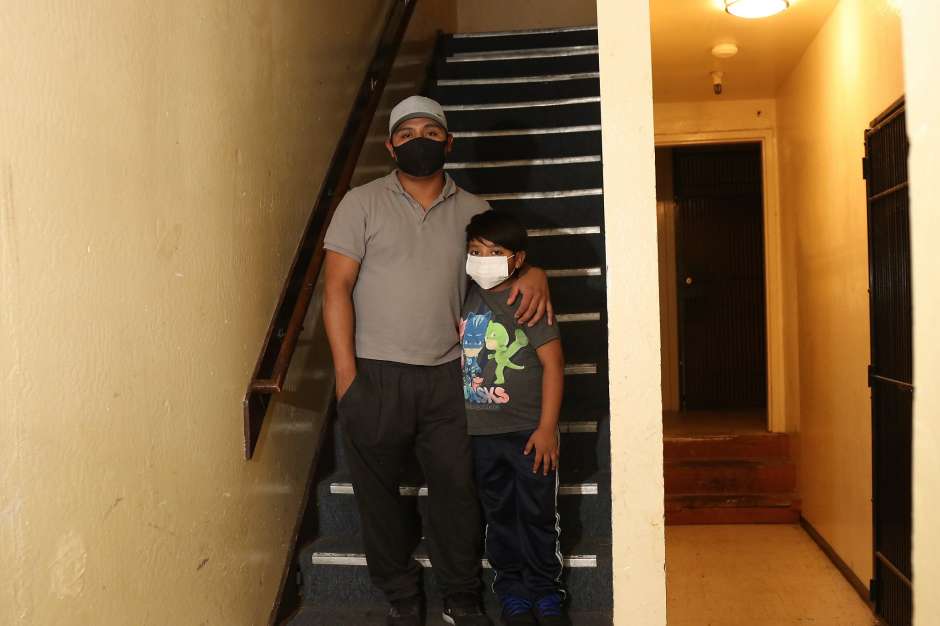Distance learning for some kids at SF elementary school came with an extra challenge: No internet connection

Joel Ramirez and 9-year-old son Wilder at their shared apartment on Third Street in Bayview-Hunters Point. Wilder, who attends Bret Harte Elementary while his dad works in construction, only recently got internet access. Photo: Jennifer Cortez
June 19, 2020
Joel Ramirez and his 9-year-old son, Wilder, live in a small room in a shared apartment on Third Street in Bayview-Hunters Point. It’s one of San Francisco’s last low-income neighborhoods, home mostly to immigrants and people of color. Normally during the school year, Wilder attends Bret Harte Elementary School while his dad works a job in construction. But when the coronavirus pandemic hit in March, Bret Harte, like almost every school in California, shifted to distance learning.
Students in kindergarten through second grade were taught through work packets they picked up at the school, while students in grades 3 and up were asked to meet with teachers over Google Classroom, a free service that allows online collaboration. Classes met for between two and four hours a day, with the curriculum up to the teachers.
“This is all new,” Denise Kleckner, Wilder’s third-grade teacher, said before instruction ended last month. “We’re trying to figure out what to do.”
Kleckner, 30, a teacher at Bret Harte for five years, developed a routine early on. She began class at noon each day. She spent the first two hours on language learning, with virtual read-alouds and collaborative writing assignments via a chat feature. The next two hours focused on math. Students watched YouTube videos about arithmetic and worked out problem sets.
Or at least some did. But Wilder and many others in his class weren’t able to participate. Despite living in tech-savvy San Francisco, the Ramirez family had no internet service in their apartment. Neither did most kids in his class.
“The teacher is teaching online, but he is not receiving any of it,” Ramirez, 26, said of his son’s dilemma.
After the San Francisco Unified School District transitioned to online “stay at home” learning, it distributed more than 12,000 Chromebook laptops to students in need. But by late April, an estimated 5,000 students still could not attend class virtually because they didn’t have adequate internet service at home. Chromebooks, unlike more common desktop and laptop computers, are built to work online, with limited offline capacity.
“The computer is kind of a paperweight if you can’t connect to the internet,” Kleckner said.
Weak or nonexistent internet connection is not a new problem in Bayview-Hunters Point, nor is it unique in many areas of the state. In California, 43% of rural residents did not have access to reliable broadband in 2017, according to research by the Haas Institute for a Fair and Inclusive Society at UC Berkeley.
And only a third of Californians had more than one choice of high-speed internet provider, the Haas study found.
Another study, by the National Digital Inclusion Alliance, which advocates for online access, found that in San Francisco almost 11% of residents lacked internet access at home in 2018, while 20% relied on low-speed dial-up access.
Vinhcent Le, technology equity legal counsel at the Greenlining Institute, a nonprofit group that advocates for economic and racial justice, says a lack of competition and low-quality internet infrastructure means some rural and low-income communities pay high prices for slow service, or can’t afford the available service at all.
While access to Wi-Fi might seem essential, the Ramirez family had more urgent concerns before the pandemic. “We don’t even have enough money for rent,” Ramirez said. His job in construction pays him barely enough to make ends meet, he said.
Since the pandemic began, though, some of the consequences of having to rely on slower or unavailable internet have become clear.
“Your kids don’t have the same access to education as other kids,” said Ernesto Falcon, senior legislative counsel at the Electronic Frontier Foundation, an organization that works on digital rights issues.
Kleckner is acutely aware of the inequities among the kids in her class. Twenty out of her 23 students are “English Language Learners,” meaning they often speak another language with their families. All lacked internet connections at home when classes moved online. So over the past few months, in addition to teaching, Kleckner has had to serve as an ad hoc IT consultant and translator for her students and their families.
“I have spent hours and hours on the phone to help them get connected to technology,” she said.
From the start, Kleckner tried to help families like the Ramirezes arrange temporary high-speed access through Comcast. The cable company made 60 days of high-speed internet free to new customers through a program called Internet Essentials. But for many Bret Harte families, Kleckner said, the program fell short.
“I had families who were waiting on the phone for three hours and their phone died before they even got through,” Kleckner said.
Comcast also partnered with SFUSD in mid-April. The district agreed to cover initial costs of the Internet Essentials program for certain families. But Kleckner said she was unaware of this agreement.
The shift to online learning has also put additional pressure on the school district. SFUSD says it faces a $130 million budget shortfall for the next fiscal year — double what had been projected. Officials are planning on $56 million in cuts to services, but expect that number to grow.
The district spent more than $7 million trying to equip students and staff with adequate technology, a big hit on its already stressed budget. Private donations alleviated some of the burden, but the district hopes to see further relief from public funding at the state and federal level.
“It is absolutely criminal that in one of the wealthiest, tech-savvy cities ever, families are unable to access Wi-Fi,” said Bita Nazarian, director of 826 Valencia, a San Francisco education nonprofit that serves 9,000 low-income students annually. Programming the nonprofit ordinarily offers has been disrupted by the pandemic, too, Nazarian says, and many of the students she works with are struggling to get online.
Shamann Walton, who represents Bayview-Hunters Point on the San Francisco Board of Supervisors, said he’s struggled to get his constituents the internet access they need.
“It’s been slow to develop,” he said.
Comcast says it provides coverage to 98% of San Francisco. But nearly 15% of public school students lacked internet access as of 2018, according to the mayor’s office, including 30% of African American and Latino students.
SFUSD also tried to solve the connectivity problem by sending families hotspot devices, which allow them to get online via cellular data networks. But deployment was slow.
It wasn’t until May 16 that a district-provided hotspot arrived on the Ramirezes’ doorstop. The final day of instruction at elementary schools like Bret Harte was May 22. So Wilder Ramirez was able to attend the last few days of third grade.
Kleckner is glad that families like Wilder’s ultimately got online, but with the summer months arriving, she fears the rapid switch to online instruction and district-wide scramble to provide technology might have been too little, too late.
“I just worry that my students are going to end up falling further behind,” she said.
Wilder will be able to keep his Chromebook and have internet access during the summer, and Kleckner is urging his father to sign him up for classes through 826 Valencia. But his teacher worries that families like Wilder’s may not have the digital literacy or tools to access other services they may need, such as counseling and other support programs.
At the beginning of the school year, a third of Kleckner’s third-graders, including Wilder, tested at a kindergarten or first-grade reading level. Kleckner hoped to see them progress more than a grade level in reading by the school year’s end. The disruption her kids have endured means that hope will almost certainly go unfulfilled.
“The learning loss is going to be tremendous,” Walton said.
Miki Katoni and Nina Sparling are freelance reporters. Jennifer Cortez contributed reporting.



